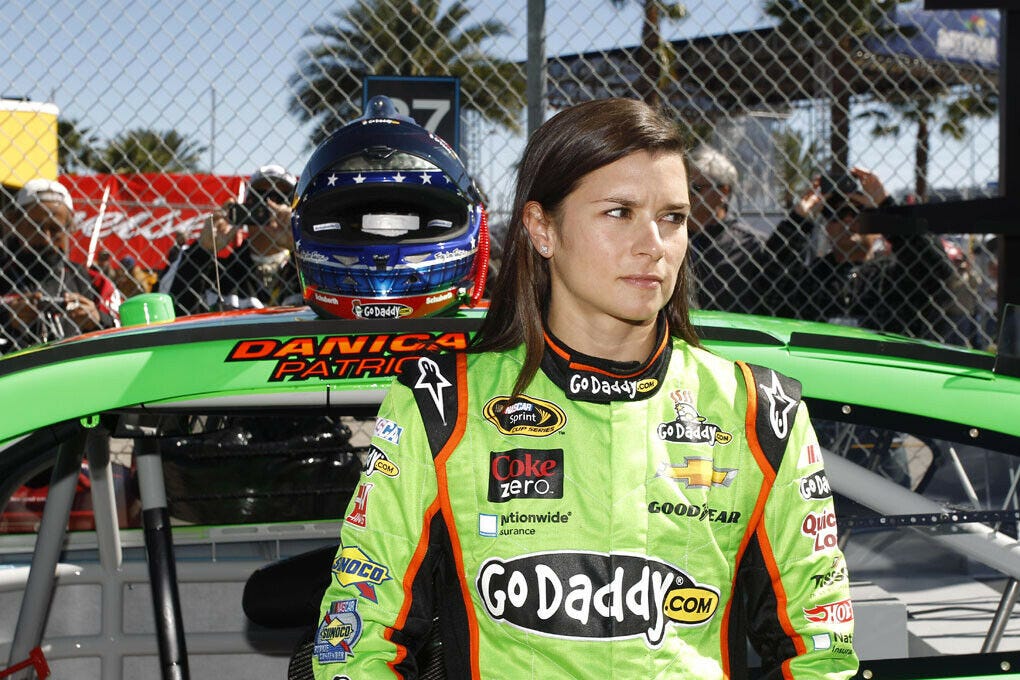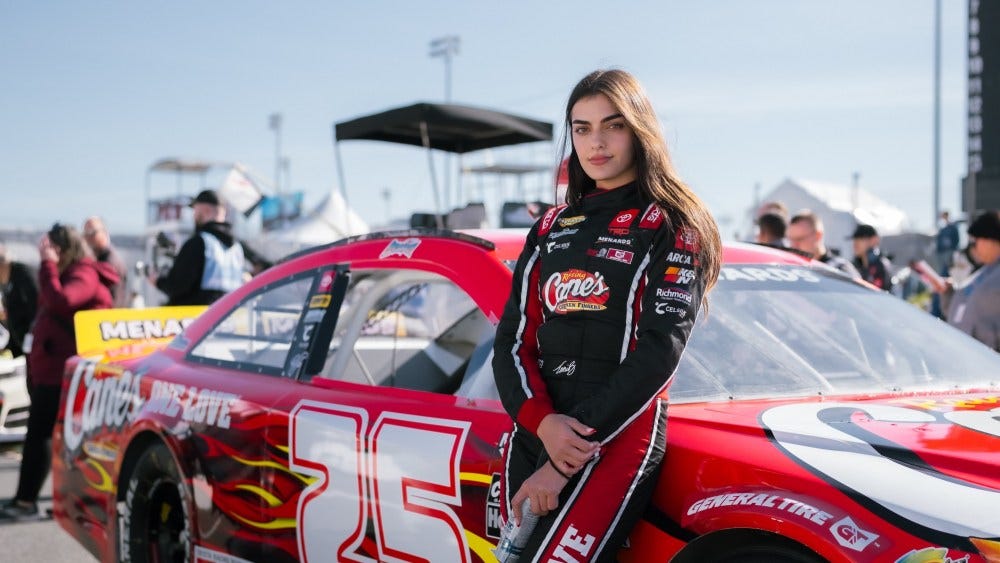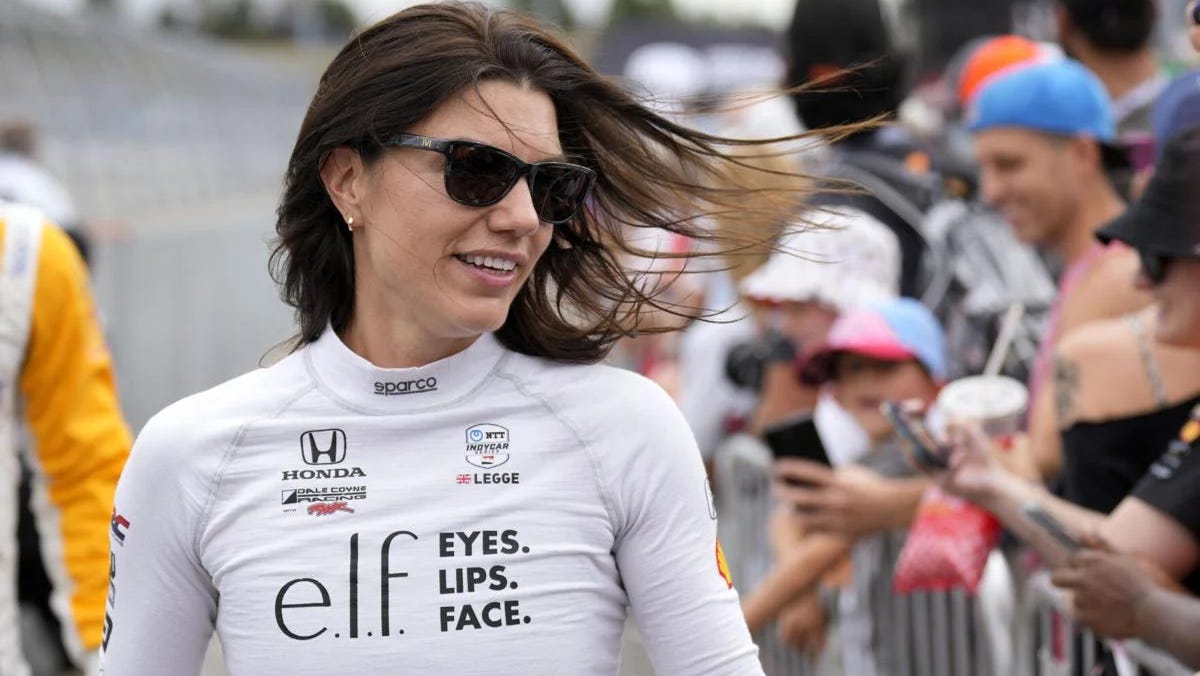Katherine Legge’s NASCAR Cup Series Debut Shows How Far Women Have Come — And How Far There Is to Go
After Danica Patrick, why has it taken 7 years for another woman to debut — one even older than Patrick is now?

A week after Connor Zilisch, one of the youngest drivers in recent NASCAR Cup Series history, made his debut at 18 years and 223 days old, we’re now set to get one of the oldest debut drivers of the past few decades, making a debut at age 44 years and 240 days next Sunday.1
Of course, that’s not even close to the most notable thing about Katherine Legge, who will drive her first-ever Cup race behind the wheel of the No. 78 Live Fast Motorsports Chevrolet at the Shriners Children's 500 in Phoenix. More importantly, Legge is the first woman to drive in the Cup Series since Danica Patrick ended her 9-year career in NASCAR national series at the 2018 Daytona 500.
Legge is no stranger to just about every type of motorsports, driving everything from IMSA sports cars to IndyCars, Champ Cars, Formula E electric cars, German touring cars and NASCAR Xfinity Series cars. She was even a Formula 1 test driver for Team Minardi in 2005. But she takes to the track Sunday as both a trailblazer, but also a symbol of how progress for women in racing has advanced in fits and starts rather than a straight line.
A “Dream” Delayed
“Entering the NASCAR Cup Series is a dream come true,” Legge said after her seat at Phoenix was announced. “Racing stock cars has been an incredibly fun and new challenge that’s given me a renewed sense of vigor for this sport.”
But the reality is, this opportunity comes far later than it probably should have — if not for Legge herself, then at least for another female driver.
I firmly believe it’s usually impolite to talk about a woman’s age, except to say that it is actually significant here — because Legge is 1 year and 256 days older than Patrick, more than seven years after the latter last raced in the Cup Series.
In some ways, Legge’s dream was deferred but not denied: She’s been a capable driver for a long time, and probably could have at least gotten a cup of coffee at the highest level of stock cars sooner. (Patrick debuted at age 29 in 2012, for instance, when Legge was 31 and driving regularly in IndyCar.)
But it’s just as much a sign that the pipeline of post-Danica female drivers hasn’t been thriving the way many had expected.
The Danica Effect — and the Weight of Expectations
Patrick wasn’t the first woman to drive in NASCAR — Sara Christian owns that honor, earned at the very first Cup Series race on June 19, 1949 in Charlotte. Two other women, Ethel Mobley and Louise Smith, also drove in that inaugural season, establishing a history of female competitors in stock car racing that far predates efforts at gender equality in other sports.
That tradition was carried on by a few others over the following decades, most notably Janet Guthrie (a truly remarkable person who was a literal rocket scientist before becoming the first woman to drive in the Indianapolis 500 and the Daytona 500) along with Patty Moise and Shawna Robinson. However, Patrick was without a doubt the most hyped, most promising, most widely marketed — and most closely scrutinized — female driver in the history of NASCAR, which we talked about a bit in Episode 10 of
here:2Unlike Legge, who was largely a journeywoman in American open-wheel series, Patrick entered the NASCAR world after contending for the IndyCar championship in 2008 and 2009,3 and finishing third in the 2009 Indy 500. The history of IndyCar-to-NASCAR transitions is itself somewhat fraught, with outcomes ranging from Patrick’s future boss, Tony Stewart (wildly successful) to Scott Speed (a bust) and everything in between (Juan Pablo Montoya, A.J. Allmendinger, Sam Hornish Jr.). But Patrick had shown the acumen to make the leap — and she was the right age to continue developing, especially since she would be running the Nationwide Series for a couple of years to get acclimated to stock cars.
(Plus, let’s be very honest: Patrick’s combination of charisma, looks and marketability made her a magnet for sponsorship dollars.)
With all of that, though, the expectations set upon Patrick were immense. She was instantly one of the faces of a sport she was trying to learn at the same time, with (unfair) pressure to win on behalf of female drivers everywhere, while trying to hold her own in a garage full of guys who were — let’s just say — varying degrees of welcoming.
In that environment, it was impressive that Patrick did show rapid improvement at the Nationwide level, scoring a Top 5 and three Top 10s in 12 races during her second season there in 2011. Her average finish that year (17.4) was 20 percent better than the series average. Patrick seemed as ready for the big-time as she was going to be — though her debut Cup season in 2012 was rough: in 10 races, she never finished any better than 17th, landing outside the Top 27 on seven occasions.
Patrick did improve the following season, going from an Adjusted Pts+ index 65 percent worse than average as a rookie to 52 percent worse in Year 2, and she came within 35 percent of average in Year 3. She also had a few breakout moments, such as finishing 8th (and leading 5 laps) from the pole in her second career Daytona 500 in 2013,4 scoring her best-ever finish of 6th at Atlanta in 2014, and leading 11 of 90 laps at The Glen in 2016 — or consistent efforts like Kansas in 2014, which made it seem like Patrick could be a fixture in the front of the pack at the Cup Series’ bread-and-butter tracks.
But for all of her flashes of brilliance, Patrick never reached the level of an average Cup driver, no matter how we slice things. Her best season by Pts+ index (65 in 2014) saw her perform 35 percent worse than average. Her best average Driver Rating of 63.1 in 2015 was below the series average of 70. Her best head-to-head record against the field in a season was when she went 703-809 (a 46.5 winning percentage) in 2015. And this was despite possessing good equipment driving for Stewart-Haas Racing — where her teammates generally drove circles around her:
Over seven Cup seasons, Patrick went 126-388 (24.5 percent) head-to-head against her teammates, a group that the rest of the field beat head-to-head 36.3 percent of the time. Overall, in 191 career Cup Series starts, she never won a race, never had a Top 5, and finished Top 10 just seven times.
For all the otherworldly build-up and promotion, Patrick didn’t quite live up to those expectations as the highest-profile female driver in the history of the sport. And that may have had an effect on subsequent generations of women trying to find their own way in stock car racing.
Where Are the Next-Gen Female Drivers?
From 2003 — the year after Robinson’s final season — until this weekend, Patrick was the only woman to drive at NASCAR’s highest level. But others drove in lower levels after Patrick’s NASCAR debut in 2010, to varying degrees of success and staying power.
The most prolific national-series female driver of this era was Jennifer Jo Cobb, who has run 265 total races across all levels (231 in the Truck Series). But she is about 9 years older than Patrick, and had broken through to drive in Xfinity well before 2010. (Cobb was actually set to drive Cup at Talladega in 2021, essentially doing what Legge is now, but she was not approved because of a lack of previous practice time in a Cup car.) So, similar to Legge, it’s hard to argue that Cobb would be part of some post-Patrick renaissance of women in NASCAR.
We do see a boom of female drivers who were born in the years after right after Patrick’s birth in 1982, and the most notable of them were of an age to be influenced by Patrick — Johanna Long (66 races), who was 17 when Patrick debuted in the Nationwide Series; Natalie Decker (44 races), who was 12; and Hailie Deegan, who was eight.
There’s also Toni Breidinger, the 25-year-old California native who is driving full-time in the Truck Series this season. But each of the current generation of prospects also showcases just how difficult it was for Patrick to reach her level of success — which ultimately amounted to a below-average Cup Series career.
Long has been out of high-level racing for a while now. Decker took a step back from the regular Xfinity or Trucks schedule. Deegan has struggled to distinguish herself in Xfinity (her Pts+ was 38 percent below average last year). And Breidinger has still seen more success as a model than as a driver, at least when it comes to major national series.
Legge, and Looking to the Future
Which brings us back to Legge, and what the present — and the future — for female drivers may hold.
On the one hand, it’s great that Legge is getting the opportunity, especially when so many talented drivers never do. She’s a highly skilled driver, with a wealth of experience in almost literally every type of racecar. But this isn’t a young talent making waves — it’s a veteran who has had to scrape together chances in different disciplines for decades, finally getting a shot.
It’s striking that NASCAR’s first new female Cup driver in seven years is older than Danica Patrick is now — at an age when most drivers are winding down their careers,5 not making their debuts. Whether because of a lack of support, problems in the development pathway, funding issues, a focus on sex appeal over skill, or all of the above, the fact that no younger female driver has emerged since Patrick suggests a broader issue in how women rise through the ranks of stock-car racing.
So while Legge’s Cup debut is a special milestone, it also exposes the gaps in the sport’s pipeline for female talent. Whether through something comparable to the W Series or F1 Academy, incentivizing the OEMs to do a better job of investing in female talent, or a totally different idea,6 a true commitment to having more women behind the wheel must be more sustainable than simply staging one-off opportunities for PR buzz.
For now, Legge’s debut may not represent the spark of a new generation of female NASCAR drivers that many were hoping for in the wake of Patrick’s career. But hopefully, it is at least a sign that more women will get the opportunities to drive that they deserve.
Filed under: NASCAR
Specifically, it will be the sixth-oldest debut since 2005 (though only the second-oldest of 2025 so far):
1. Andy Pilgrim, 2011 (54 years, 312 days)
2. Tomy Drissi, 2012 (53 years, 198 days)
3. Kevin O'Connell, 2017 (50 years, 57 days)
4. Helio Castroneves, 2025 (49 years, 283 days)
5. Bill Lester, 2006 (45 years, 42 days)
6. Katherine Legge, 2025 (44 years, 240 days)
We used to focus on a particularly notable driver who had the same number as the episode — hence, No. 10 for Danica.
She finished 6th out of 25 regular drivers in the 2008 standings (rising as high as 3rd place at one point) and ranked 5th in 2009.
She went into the final lap running third.
Martin Truex, Jr. retired from full-time racing at age 44 last season — the same age when Legge is debuting.
And, to be fair, NASCAR does have the Drive for Diversity program, which tries to identify and promote minority and female talent in the sport.









